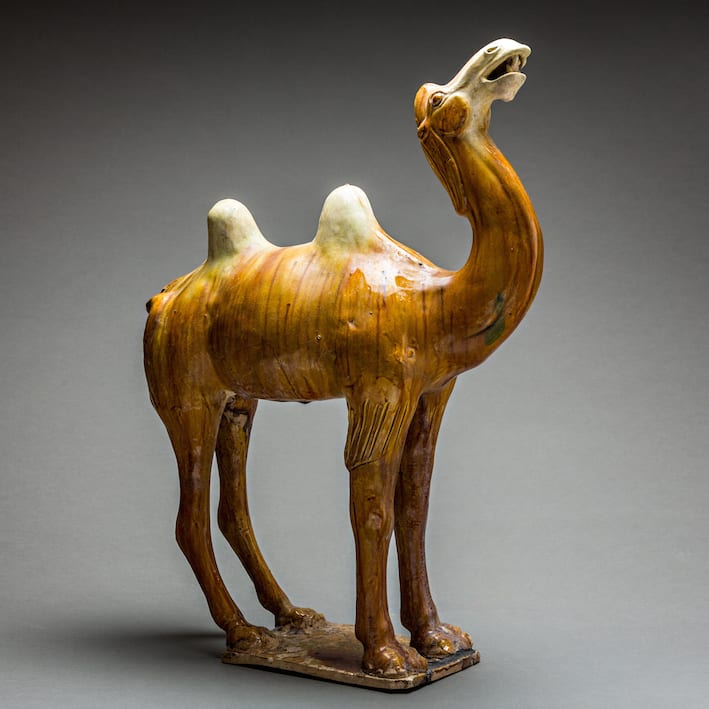Tang Glazed Terracotta Camel and Foreign Groom, 618 CE - 906 CE
Glazed Terracotta
height 52.1 cm
height 20 1/2 in
height 20 1/2 in
H.741
Further images
The male figure holds his right arm in the air as if leading the camel; the image so clear we can almost see the reigns from his hands to the...
The male figure holds his right arm in the air as if leading the camel; the image so clear we can almost see the reigns from his hands to the head of the camel. While the groom leads the way the camel stands erect with head held high at 52.1cm, perhaps pulling back slightly on the reigns. Both camel and groom are elegantly glazed in brown hues that complement the natural coat of the camel. Additional attention has been given the paint strokes on the camel, giving it a more realistic looking coat. The physical appearance of the groom indicates that he is probably of foreign decent, most likely from Central Asia.
This mingqi sculpture reveals the Tang Dynasty’s respect and admiration for this beast of burden, so essential to the prosperity of ancient China. Mingqi is a general terms used in Chinese art referring to objects specifically created for interment in the tombs of elite individuals in order to provide for the afterlife. Chinese spirit guardians are understood to have come in pairs and stood guard over the tombs to ward off any evil-sprits or robbers.
The Tang Dynasty was an era of unrivalled wealth and luxury. The arts reached new levels of sophistication. Poetry and literature flourished under the enlightened rulers. Tang China was a multicultural empire where foreign merchants from across Central Foreign traders lived next to native artisans and both thrived. New ideas and exotic artistic forms followed alongside. In essence the Tang Dynasty was a cultural renaissance of sorts, where many of the forms and objects we now associate with China were first created. Moreover, this period represents one of the greatest cultural outpourings in human history. - (H.741)
This mingqi sculpture reveals the Tang Dynasty’s respect and admiration for this beast of burden, so essential to the prosperity of ancient China. Mingqi is a general terms used in Chinese art referring to objects specifically created for interment in the tombs of elite individuals in order to provide for the afterlife. Chinese spirit guardians are understood to have come in pairs and stood guard over the tombs to ward off any evil-sprits or robbers.
The Tang Dynasty was an era of unrivalled wealth and luxury. The arts reached new levels of sophistication. Poetry and literature flourished under the enlightened rulers. Tang China was a multicultural empire where foreign merchants from across Central Foreign traders lived next to native artisans and both thrived. New ideas and exotic artistic forms followed alongside. In essence the Tang Dynasty was a cultural renaissance of sorts, where many of the forms and objects we now associate with China were first created. Moreover, this period represents one of the greatest cultural outpourings in human history. - (H.741)
Provenance
The antiquity of this artefact was tested with Thermolumiscence by Oxford Authentication LTD. The certificate is provided upon acquisition.Literature
V33







